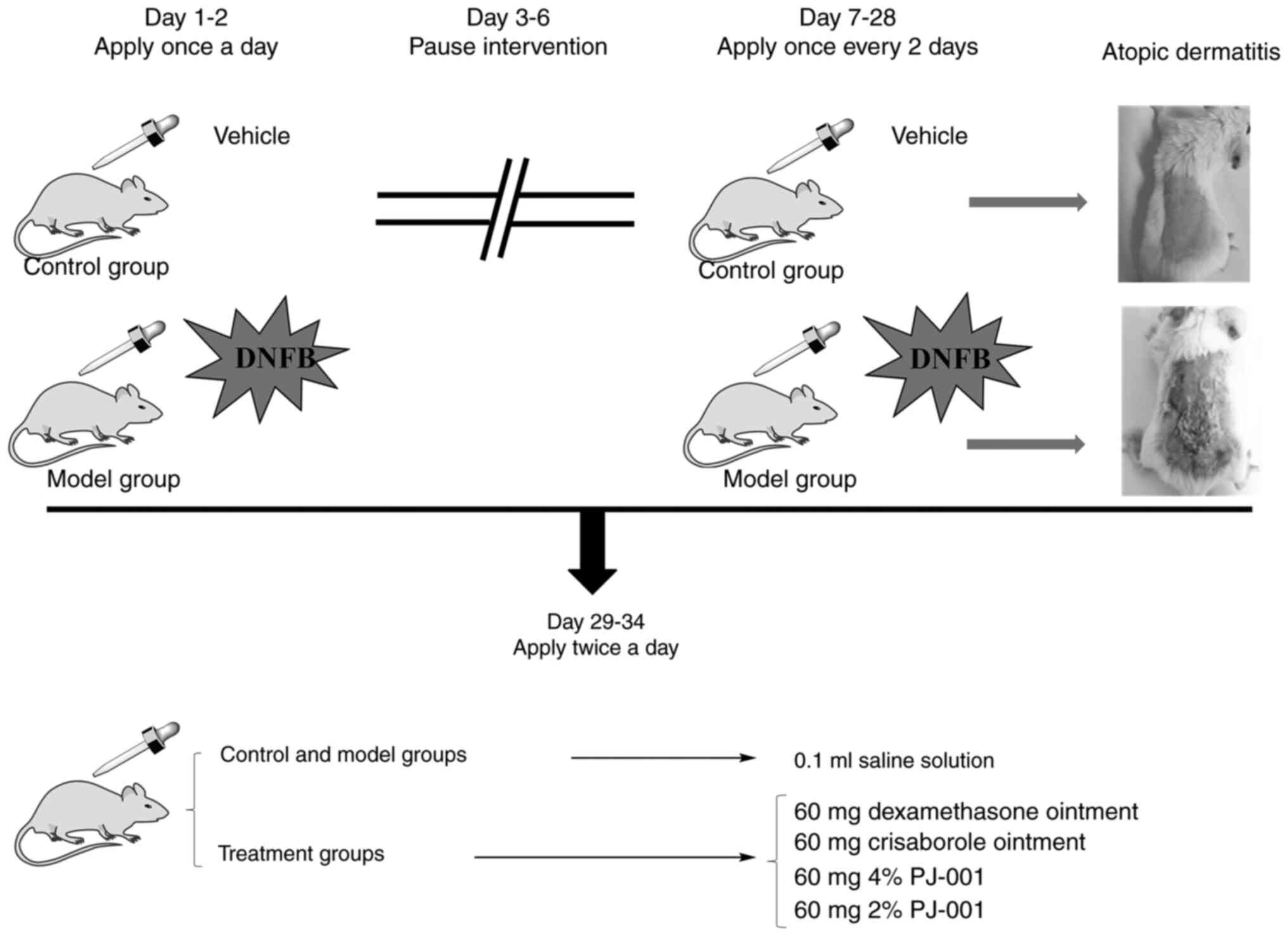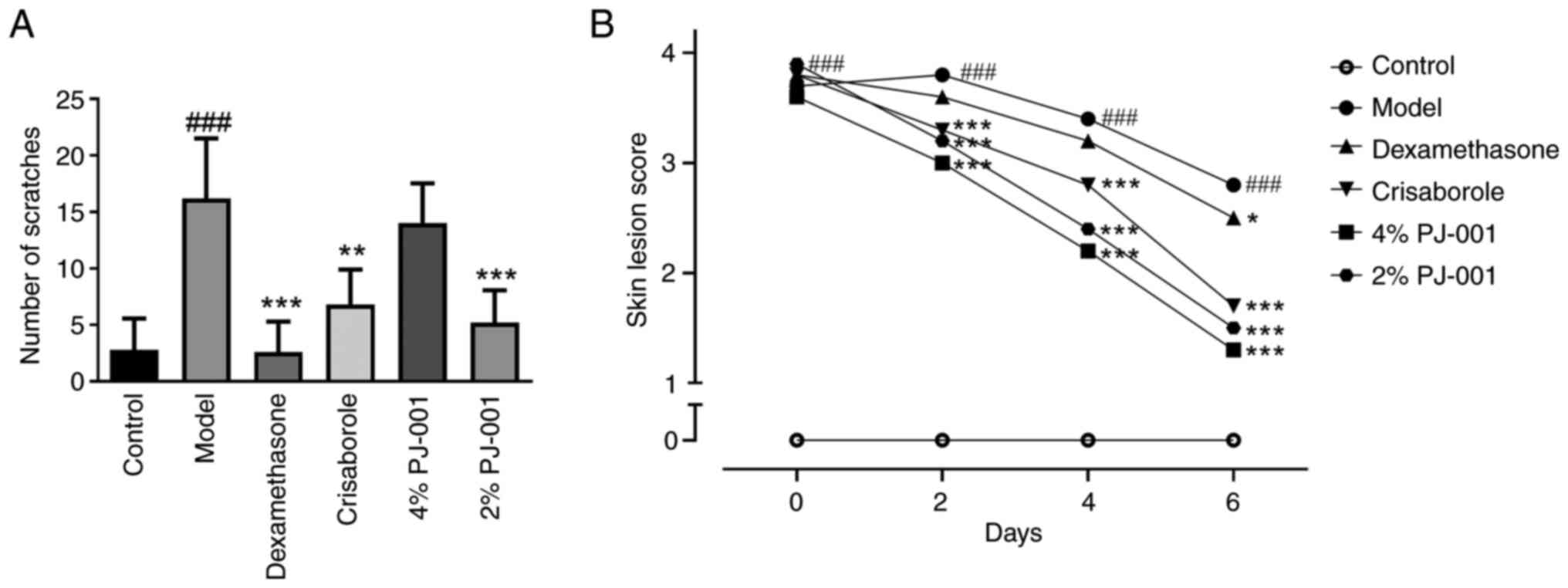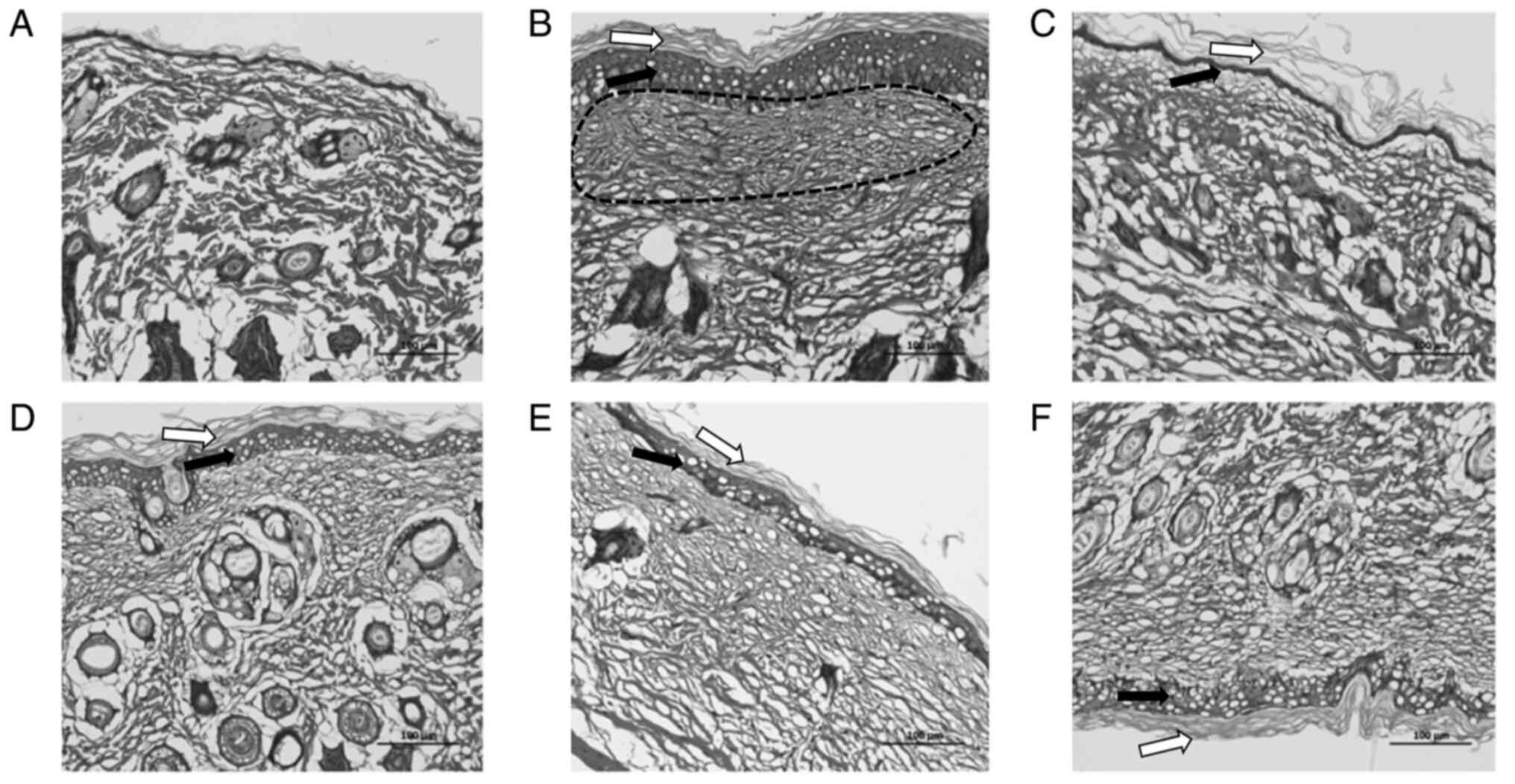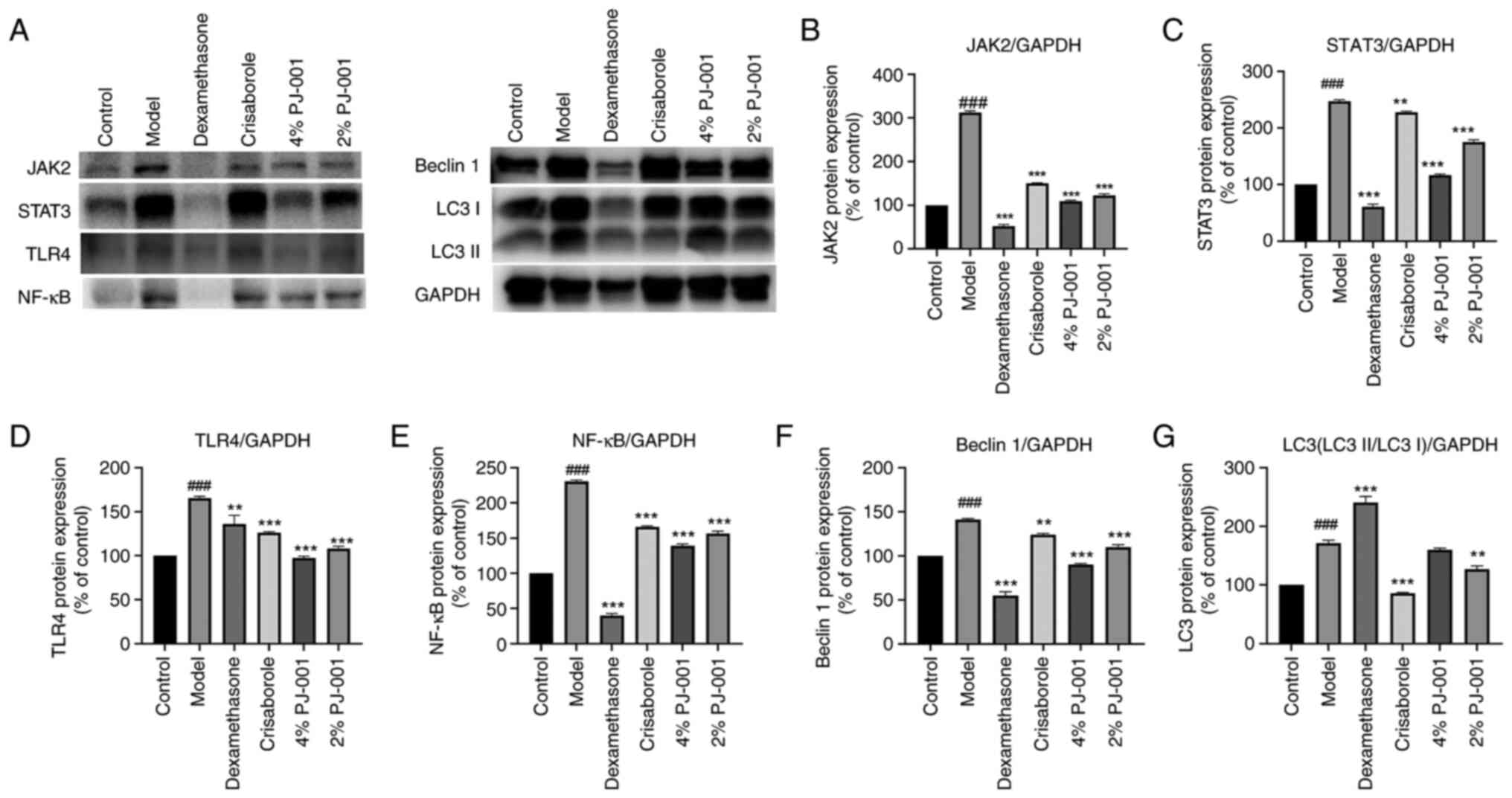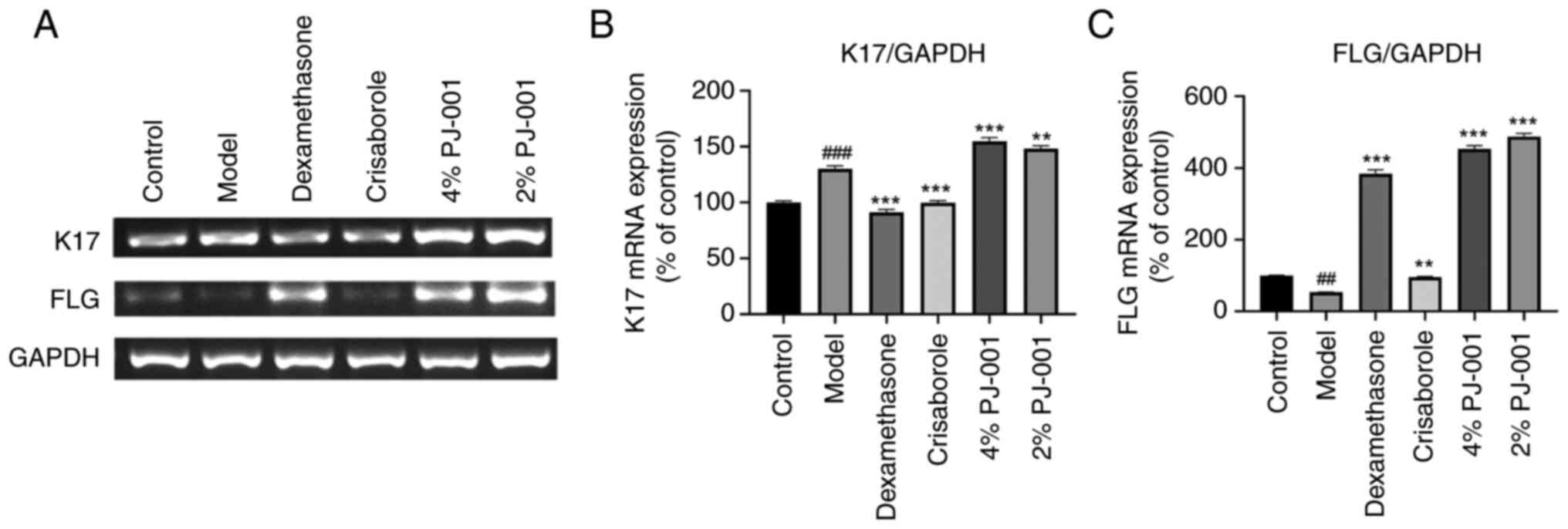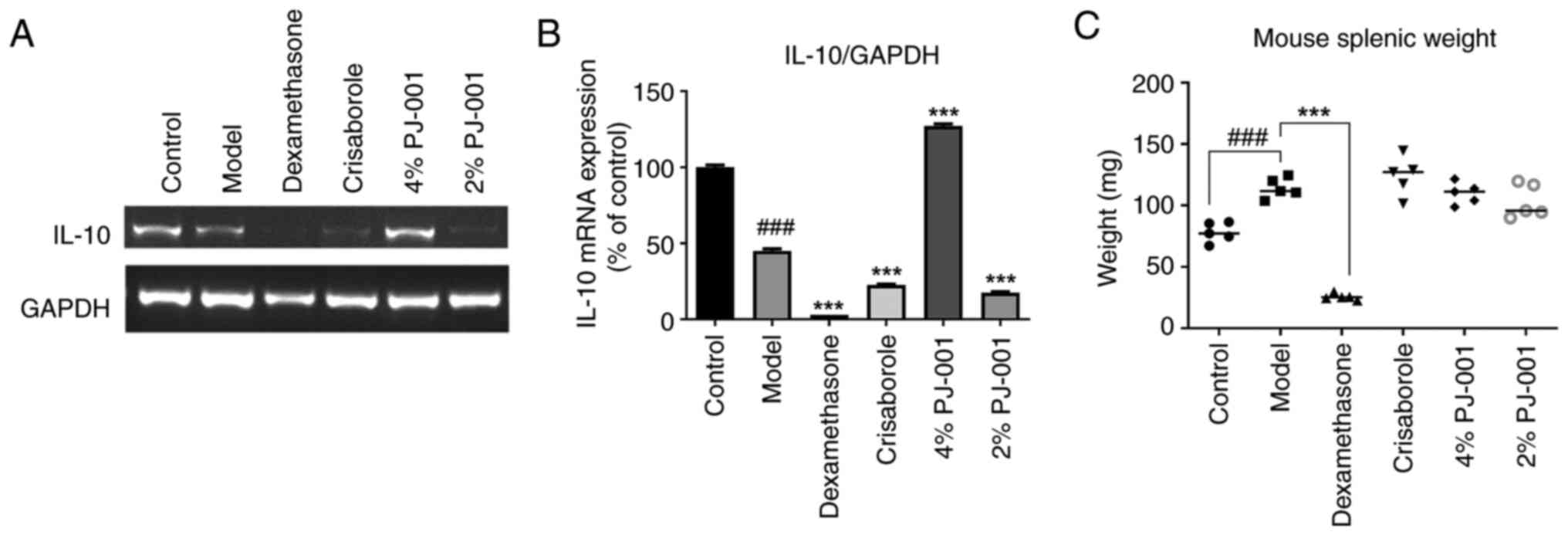|
1
|
Hadi HA, Tarmizi AI, Khalid KA, Gajdács M,
Aslam A and Jamshed S: The epidemiology and global burden of atopic
dermatitis: A narrative review. Life (Basel).
11(936)2021.PubMed/NCBI View Article : Google Scholar
|
|
2
|
Cornaghi L, Gagliano N, Preis FWB,
Prignano F and Donetti E: Inside-out and outside-in organotypic
normal human skin culture: JAK-STAT pathway is activated after
pro-inflammatory psoriatic cytokine exposure. Tissue Cell.
74(101675)2022.PubMed/NCBI View Article : Google Scholar
|
|
3
|
Moosbrugger-Martinz V, Leprince C, Méchin
MC, Simon M, Blunder S, Gruber R and Dubrac S: Revisiting the roles
of filaggrin in atopic dermatitis. Int J Mol Sci.
23(5318)2022.PubMed/NCBI View Article : Google Scholar
|
|
4
|
De Vuyst E, Salmon M, Evrard C, Lambert de
Rouvroit C and Poumay Y: Atopic dermatitis studies through in vitro
models. Front Med (Lausanne). 4(119)2017.PubMed/NCBI View Article : Google Scholar
|
|
5
|
Welsch K, Holstein J, Laurence A and
Ghoreschi K: Targeting JAK/STAT signalling in inflammatory skin
diseases with small molecule inhibitors. Eur J Immunol.
47:1096–1107. 2017.PubMed/NCBI View Article : Google Scholar
|
|
6
|
Bao L, Zhang H and Chan LS: The
involvement of the JAK-STAT signaling pathway in chronic
inflammatory skin disease atopic dermatitis. JAKSTAT.
2(e24137)2013.PubMed/NCBI View Article : Google Scholar
|
|
7
|
Wang L, Xian YF, Loo SKF, Ip SP, Yang W,
Chan WY, Lin ZX and Wu JCY: Baicalin ameliorates
2,4-dinitrochlorobenzene-induced atopic dermatitis-like skin
lesions in mice through modulating skin barrier function, gut
microbiota and JAK/STAT pathway. Bioorg Chem.
119(105538)2022.PubMed/NCBI View Article : Google Scholar
|
|
8
|
Goenka S and Kaplan MH: Transcriptional
regulation by STAT6. Immunol Res. 50:87–96. 2011.PubMed/NCBI View Article : Google Scholar
|
|
9
|
Tang J, Liu C, Liu S, Zhou X, Lu J, Li M
and Zhu L: Inhibition of JAK1/STAT3 pathway by 2-methoxyestradiol
ameliorates psoriatic features in vitro and in an imiquimod-induced
psoriasis-like mouse model. Eur J Pharmacol.
933(175276)2022.PubMed/NCBI View Article : Google Scholar
|
|
10
|
Kang R, Tang D, Lotze MT and Zeh HJ:
AGER/RAGE-mediated autophagy promotes pancreatic tumorigenesis and
bioenergetics through the IL6-pSTAT3 pathway. Autophagy. 8:989–991.
2012.PubMed/NCBI View Article : Google Scholar
|
|
11
|
Li H, Chen L, Li JJ, Zhou Q, Huang A, Liu
WW, Wang K, Gao L, Qi ST and Lu YT: miR-519a enhances
chemosensitivity and promotes autophagy in glioblastoma by
targeting STAT3/Bcl2 signaling pathway. J Hematol Oncol.
11(70)2018.PubMed/NCBI View Article : Google Scholar
|
|
12
|
Kim HJ, Park J, Kim SK, Park H, Kim JE and
Lee S: Autophagy: Guardian of skin barrier. Biomedicines.
10(1817)2022.PubMed/NCBI View Article : Google Scholar
|
|
13
|
Li X and Song Y: Proteolysis-targeting
chimera (PROTAC) for targeted protein degradation and cancer
therapy. J Hematol Oncol. 13(50)2020.PubMed/NCBI View Article : Google Scholar
|
|
14
|
Békés M, Langley DR and Crews CM: PROTAC
targeted protein degraders: The past is prologue. Nat Rev Drug
Discov. 21:181–200. 2022.PubMed/NCBI View Article : Google Scholar
|
|
15
|
Xiong X, Huang C, Wang F, Dong J, Zhang D,
Jiang J, Feng Y, Wu B, Xie T and Cheng L: Qingxue jiedu formulation
ameliorated DNFB-induced atopic dermatitis by inhibiting
STAT3/MAPK/NF-κB signaling pathways. J Ethnopharmacol.
270(113773)2021.PubMed/NCBI View Article : Google Scholar
|
|
16
|
Woo TE and Kuzel P: Crisaborole 2%
ointment (Eucrisa) for atopic dermatitis. Skin Therapy Lett.
24:4–6. 2019.PubMed/NCBI
|
|
17
|
Tadvalkar G, Pal-Ghosh S, Pajoohesh-Ganji
A and Stepp MA: The impact of euthanasia and enucleation on mouse
corneal epithelial axon density and nerve terminal morphology. Ocul
Surf. 18:821–828. 2020.PubMed/NCBI View Article : Google Scholar
|
|
18
|
Shomer NH, Allen-Worthington KH, Hickman
DL, Jonnalagadda M, Newsome JT, Slate AR, Valentine H, Williams AM
and Wilkinson M: Review of rodent euthanasia methods. J Am Assoc
Lab Anim Sci. 59:242–253. 2020.PubMed/NCBI View Article : Google Scholar
|
|
19
|
Zheng BW, Wang BY, Xiao WL, Sun YJ, Yang C
and Zhao BT: Different molecular weight hyaluronic acid alleviates
inflammation response in DNFB-induced mice atopic dermatitis and
LPS-induced RAW 264.7 cells. Life Sci. 301(120591)2022.PubMed/NCBI View Article : Google Scholar
|
|
20
|
Yang N, Shao H, Deng J, Yang Y, Tang Z, Wu
G and Liu Y: Dictamnine ameliorates chronic itch in DNFB-induced
atopic dermatitis mice via inhibiting MrgprA3. Biochem Pharmacol.
208(115368)2023.PubMed/NCBI View Article : Google Scholar
|
|
21
|
Gallo-Oller G, Ordoñez R and Dotor J: A
new background subtraction method for Western blot densitometry
band quantification through image analysis software. J Immunol
Methods. 457:1–5. 2018.PubMed/NCBI View Article : Google Scholar
|
|
22
|
Schuler CFt, Billi AC, Maverakis E, Tsoi
LC and Gudjonsson JE: Novel insights into atopic dermatitis. J
Allergy Clin Immunol. 151:1145–1154. 2023.PubMed/NCBI View Article : Google Scholar
|
|
23
|
Yu T and Zhi-rong Y: Research and therapy
progress on the mechanisms of pruritus in atopic dermatitis. Med J
Peking Union Med. 13:473–479. 2022.
|
|
24
|
McDowell L and Olin B: Crisaborole: A
novel nonsteroidal topical treatment for atopic dermatitis. J Pharm
Technol. 35:172–178. 2019.PubMed/NCBI View Article : Google Scholar
|
|
25
|
Wen-xing L, Ming H and Yu R: Opportunities
and challenges for PROTACs. Chinese J Med Chem. 30:745–764.
2020.
|
|
26
|
Therapeutics K: Kymera announces positive
results from phase 1 clinical trial evaluating KT-474 in patients
with HS and AD and Sanofi's decision to advance KT-474 into phase 2
clinical trials. Kymera Therapeutics, Inc., Watertown MS, 2022.
|
|
27
|
Madan J, Ahuja VK, Dua K, Samajdar S,
Ramchandra M and Giri S: PROTACs: Current trends in protein
degradation by proteolysis-targeting chimeras. BioDrugs.
36:609–623. 2022.PubMed/NCBI View Article : Google Scholar
|
|
28
|
Luger T, Amagai M, Dreno B, Dagnelie MA,
Liao W, Kabashima K, Schikowski T, Proksch E, Elias PM, Simon M, et
al: Atopic dermatitis: Role of the skin barrier, environment,
microbiome, and therapeutic agents. J Dermatol Sci. 102:142–157.
2021.PubMed/NCBI View Article : Google Scholar
|
|
29
|
Stander S: Atopic dermatitis. N Engl J
Med. 384:1136–1143. 2021.PubMed/NCBI View Article : Google Scholar
|
|
30
|
Zhao Y, Terron-Kwiatkowski A, Liao H, Lee
SP, Allen MH, Hull PR, Campbell LE, Trembath RC, Capon F, Griffiths
CE, et al: Filaggrin null alleles are not associated with
psoriasis. J Invest Dermatol. 127:1878–1882. 2007.PubMed/NCBI View Article : Google Scholar
|
|
31
|
Cha B, Lim JW and Kim H: Jak1/Stat3 is an
upstream signaling of NF-κB activation in Helicobacter
pylori-induced IL-8 production in gastric epithelial AGS cells.
Yonsei Med J. 56:862–866. 2015.PubMed/NCBI View Article : Google Scholar
|
|
32
|
Ahmad SF, Ansari MA, Zoheir KM, Bakheet
SA, Korashy HM, Nadeem A, Ashour AE and Attia SM: Regulation of
TNF-α and NF-κB activation through the JAK/STAT signaling pathway
downstream of histamine 4 receptor in a rat model of LPS-induced
joint inflammation. Immunobiology. 220:889–898. 2015.PubMed/NCBI View Article : Google Scholar
|
|
33
|
Ramadass V, Vaiyapuri T and Tergaonkar V:
Small molecule NF-κB pathway inhibitors in clinic. Int J Mol Sci.
21(5164)2020.PubMed/NCBI View Article : Google Scholar
|
|
34
|
Lesiak A, Zakrzewski M, Przybyłowska K,
Rogowski-Tylman M, Wozniacka A and Narbutt J: Atopic dermatitis
patients carrying G allele in -1082 G/A IL-10 polymorphism are
predisposed to higher serum concentration of IL-10. Arch Med Sci.
10:1239–1243. 2014.PubMed/NCBI View Article : Google Scholar
|
|
35
|
Hussein PY, Zahran F, Ashour Wahba A,
Ahmad AS, Ibrahiem MM, Shalaby SM, El Tarhouny SA, El Sherbiny HM
and Bakr N: Interleukin 10 receptor alpha subunit (IL-10RA) gene
polymorphism and IL-10 serum levels in Egyptian atopic patients. J
Investig Allergol Clin Immunol. 20:20–26. 2010.PubMed/NCBI
|
|
36
|
Zhang YY, Wang AX, Xu L, Shen N, Zhu J and
Tu CX: Characteristics of peripheral blood CD4+CD25+ regulatory T
cells and related cytokines in severe atopic dermatitis. Eur J
Dermatol. 26:240–246. 2016.PubMed/NCBI View Article : Google Scholar
|
|
37
|
Quero L, Tiaden AN, Hanser E, Roux J,
Laski A, Hall J and Kyburz D: miR-221-3p drives the shift of
M2-macrophages to a pro-inflammatory function by suppressing
JAK3/STAT3 activation. Front Immunol. 10(3087)2019.PubMed/NCBI View Article : Google Scholar
|
|
38
|
Amend A, Wickli N, Schäfer AL, Sprenger
DTL, Manz RA, Voll RE and Chevalier N: Dual role of interleukin-10
in murine NZB/W F1 lupus. Int J Mol Sci. 22(1347)2021.PubMed/NCBI View Article : Google Scholar
|















